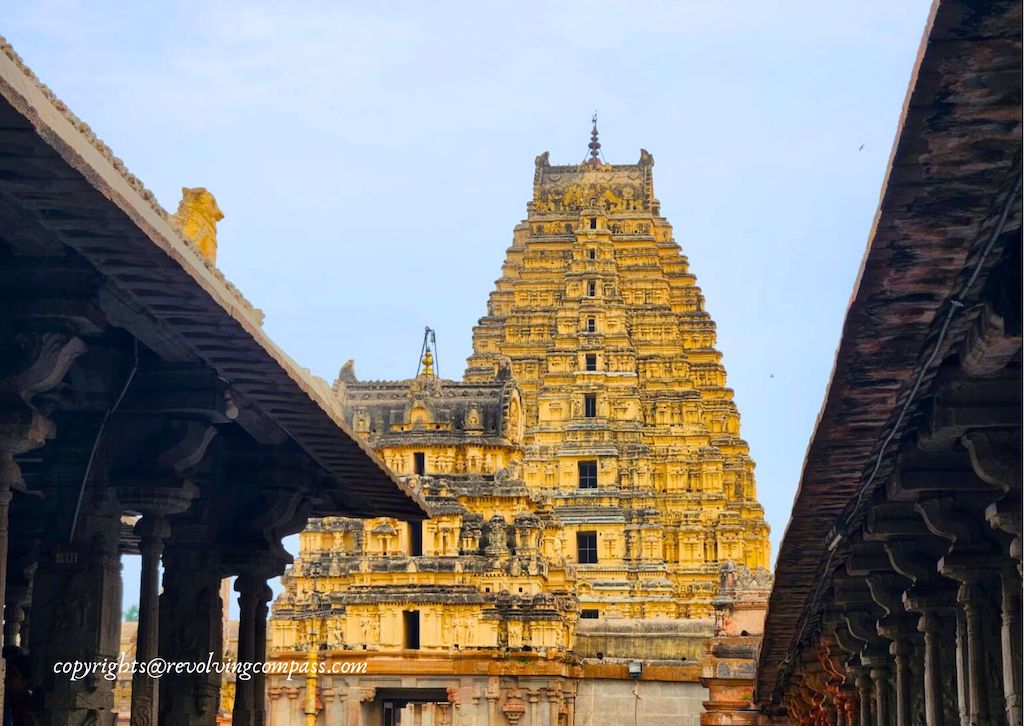Virupaksha is a form of Shiva. Thus, Virupaksha temple is dedicated to Shiva. The temple was built in around 7th Century by Lakkan Dandesha, a nayaka (chieftain) under the ruler Deva Raya II of the Vijayanagara Empire. And it is part of the UNESCO World Heritage site of Karnataka – the ruins of Hampi or the ruins of Vijayanagara Empire of Hampi. And the only ancient temple of Hampi in which active worship of God still happens.
Surprisingly, while most of the Royal Enclosures of Hampi and the remains of the constructions from the Vijayanagara Empire regions are now reduced to ruins. And Hampi stands as a ghost town. But the Virupaksha Temple and the Vittala Temple are the two temples of Hampi which still stand intact. In fact, the Virupaksha Temple is the primary temple of Hampi which is still open for daily worship.
History of Virupaksha Temple Hampi
Virupaksha Temple Hampi is one of the few structures that was initially built as a small shrine. But then it continued to evolve over the centuries. First under the rule of Vijayanagara Empire. And then later under the rule of Chalukyas and Hoysalas. While the main structure of the temple is attributed back to 7th through 9th Century, there are ceiling paintings from much later period. Perhaps from around fourteenth century, as indicated by our guide. And then there are restored pillars and parts of the temple. Which as per our guide, have been done very recently – in the 19th and 20th Centuries.

Overall, the Virupaksha temple has very well stood the test of time. And is one of the most revered ancient temples of India.
Architecture of the Virupaksha Temple Hampi
The architecture of Virupaksha Temple Hampi clearly indicated Dravidian style. And it is very evident from the main entrance of the temple itself. As it is very similar to the entrance of the Meenakshi Amman Temple and many other prominent temples of South India. For instance, it is characterised by a tall entrance tower, sometimes even taller than the main temple. And on top of the tower, several Gods, Goddesses and characters from Puranas and Upanishads are carved in different colours.
Main entryway to the Virupaksha Temple Hampi
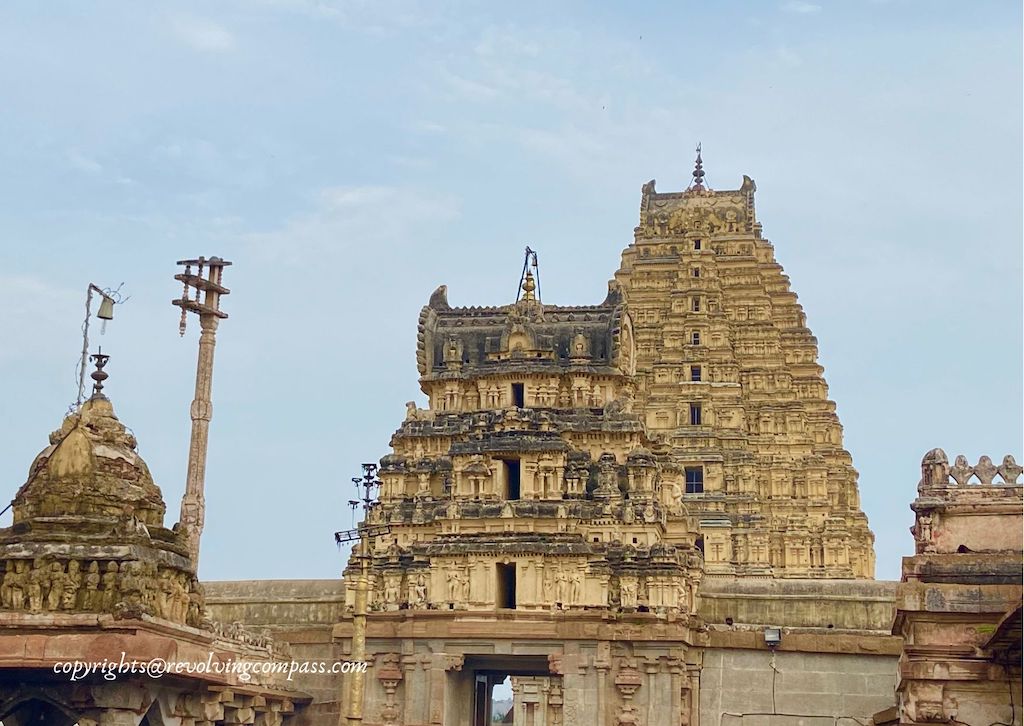
The main eastern entrance of Virupaksha Temple is 9 tiered and is more than 50 meters tall. And it is visible from far and wide, including as far as the Tungabhadra River View Point and the Tungabhadra River Ferry Point near the banks of the river Tungabhadra.
First Courtyard of the Virupaksha Temple Hampi
As you enter inside the main gate of the Virupaksha Temple Hampi, you will see yourself in the first courtyard. Across this courtyard is the second entry gate which takes you to the main courtyard of the Virupaksha Temple Hampi. I have visited only one more temple in India so far where I have seen this double courtyard concept. Which is the Brihadeeswara Temple of Thanjavur.
Second Courtyard of the Virupaksha Temple Hampi


As you enter inside the second gate, you first find yourself in a large central courtyard. And at the other end of this gate is the main temple. Also, the main temple itself consists of an outer hall, an inner hall, three chambers one followed by another which are built from the purpose of waiting area and finally an inner sanctum where the actual God is established.
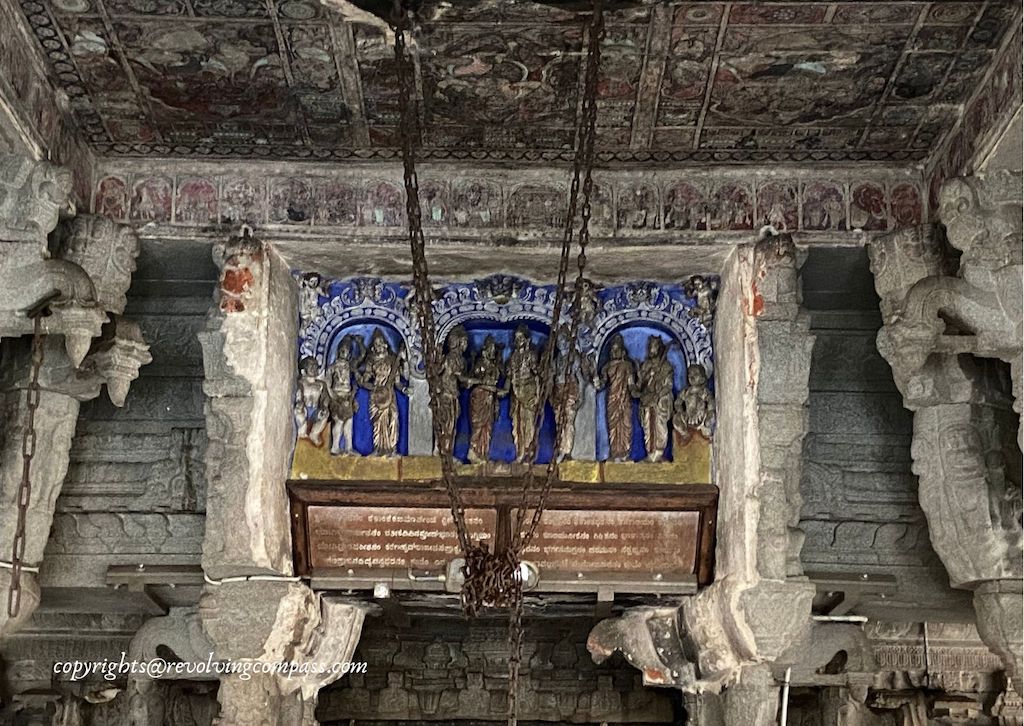
If you want, you can do a darshan of the God from the outer hall itself. And then there are special darshan tickets also available. Which you can buy at the main gate of the temple. And using which you can go inside the inner sanctum to offer prayers.
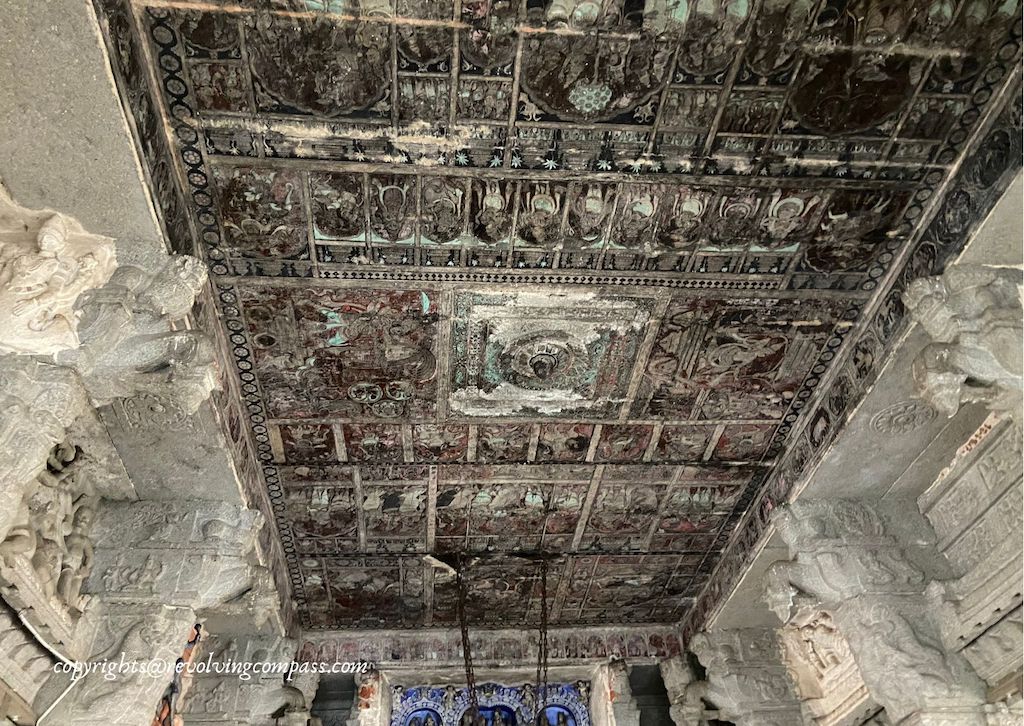
The halls of Virupaksha Temple have heavily and intricately carved pillars.
While the main temple sanctrum was for worshipping. But the larger hall outside was used to host several public functions, dances, cultural events etc. at the time of the Vijayanagara Empire.
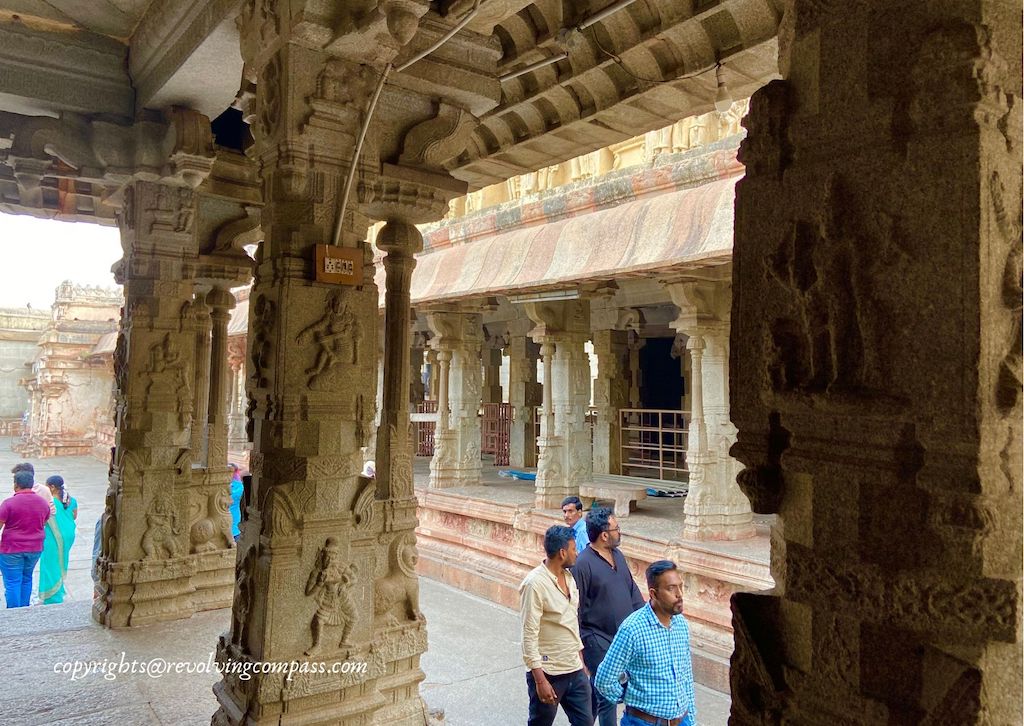
There are pillared varandah running around the boundary of the Virupaksha Temple in parallel to the main temple. Overall, the architecture of the Virupaksha Temple strongly reminded me of the Belur Temple & Halebidu temple in it’s expanse and Big Temple in it’s style. It is definitely one of the most attractive ancient temples of India.
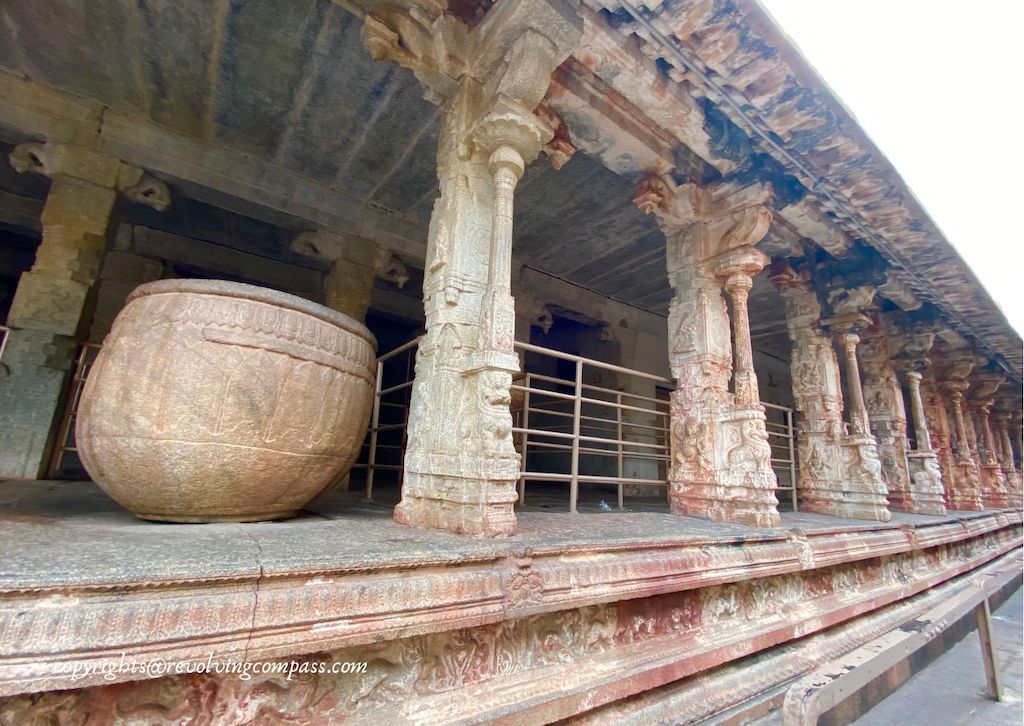
Timings of Virupaksha Temple Hampi – 6:00am to 7:00pm everyday
PS: There is an elephant inside the courtyard of Virupaksha Temple Hampi which blesses devotees with it’s trunk. Something very unique to Virupaksha Temple Hampi. Don’t miss him when you visit Virupaksha Temple.
Other places to see around Virupaksha Temple Hampi
There are a lot of places to see near Virupaksha Temple Hampi. Some are walkable from Virupaksha Temple Hampi. While others are located bit far. I am covering the ones near Virupaksha Temple below. This is the map that we followed while exploring the ruins near Virupaksha Temple Hampi –
Here’s a link to the above map – https://maps.app.goo.gl/QCsktw3Mpm3HyiJ88
Hemakuta Hills Hampi
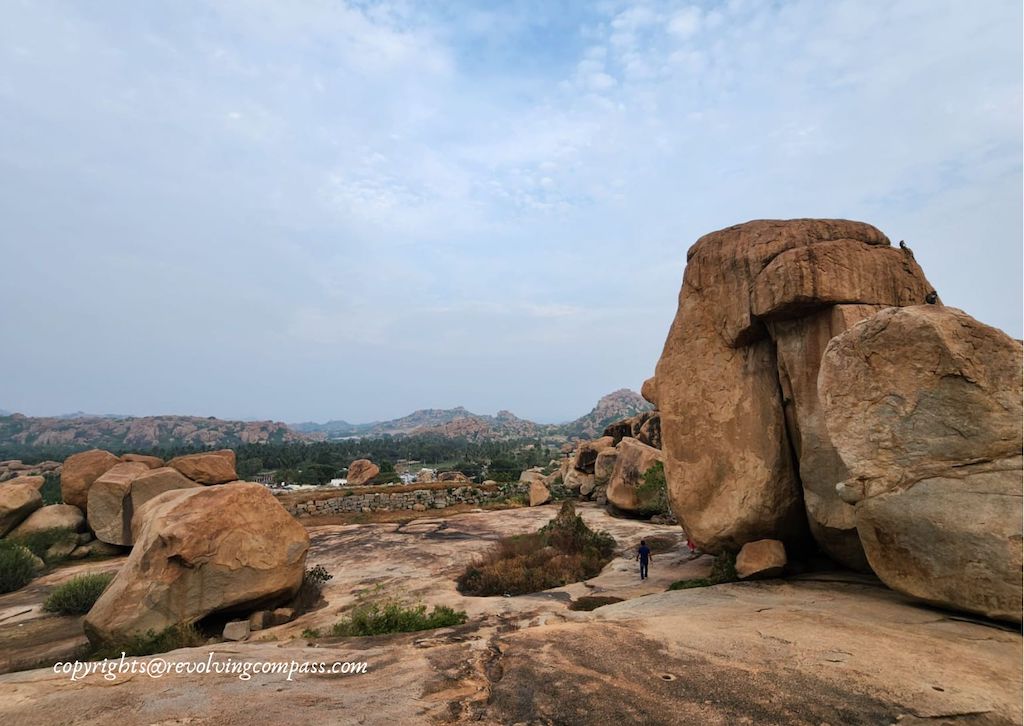
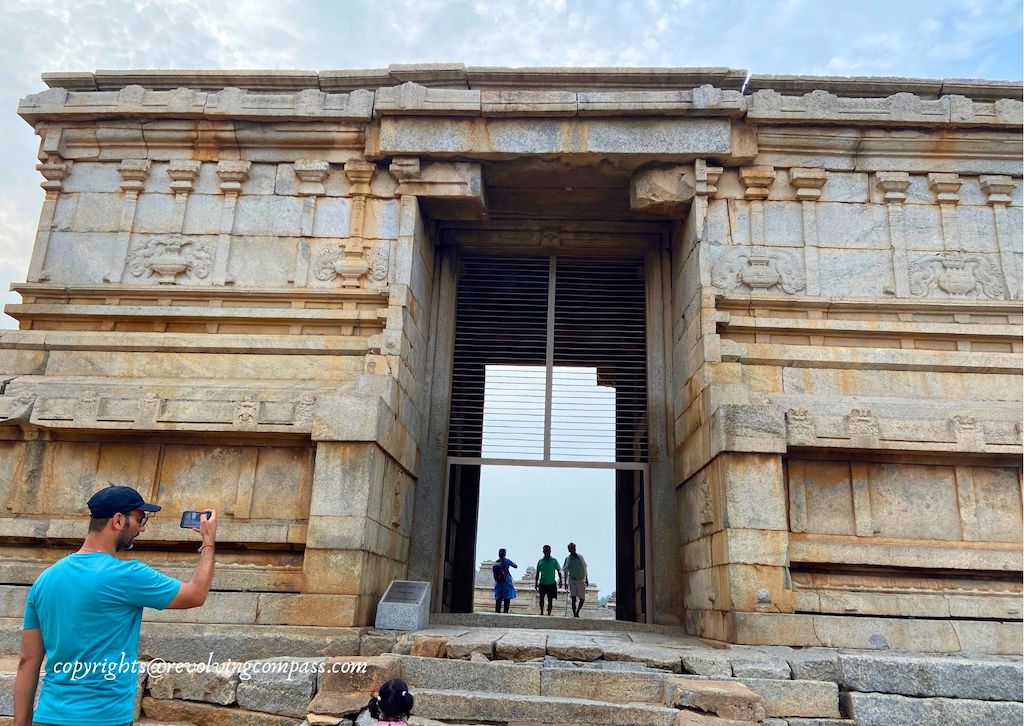
The word “Hema” literally means “Gold”. As per mythological tales, it rained gold on these hills when Shiva and Parvati married here. This is also the place where goddess Pampa, an avatar of Parvati, did years of meditation to finally win Shiva over and get married to him. The Hemakuta hills are located to the left of the Virupaksha Temple main entrance. Built of boulders like most of the other hills and around Hampi, these hills are one of the best places to visit in Hampi. And provide visitors with multiple things to see including the following –
Temples & Other structures on the Hemakuta Hills

There are 80+ temples on the Hemakuta Hills in total. Out of which, there is one temple which is dedicated to “Devi” (Parvati or Pampa Devi). And it still stands entact. many others are half destroyed or reduced to ruins.

Sunset point at Hemakuta Hills
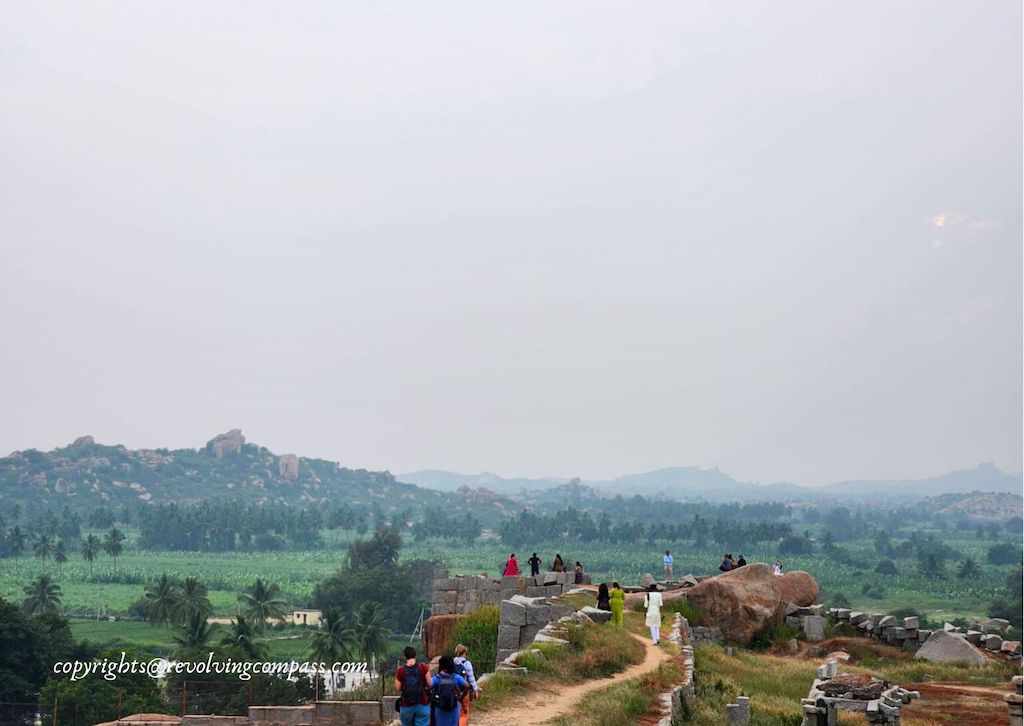
From the Hemakuta Hills, you will get excellent views of the surroundings. There is one particular point on the Hemakuta Hills called “Sunset point”. Because, you can get excellent sunset views across the bouldered hills of Hampi from here.
Ariel views of the Virupaksha Temple & Beyond

Also, from above the Hemakuta Hills you will get Ariel views of the whole campus of Virupaksha Temple. Along with the backdrop of the Tungabhadra Temple and the bouldered hills beyond it. The views from here are simply mesmerising.
Sasivekalu Ganesha Temple Hampi
As you climb the Hemakuta Hills from near Virupaksha Temple and then descend from the other side, you reach the campus of Sasivekaalu Ganesha. Although the temple itself is small, in it’s center stage lies a huge statue of Ganesha carved from a single rock. The pillars of this temple are plain. And the main attraction is the huge Ganesha itself.
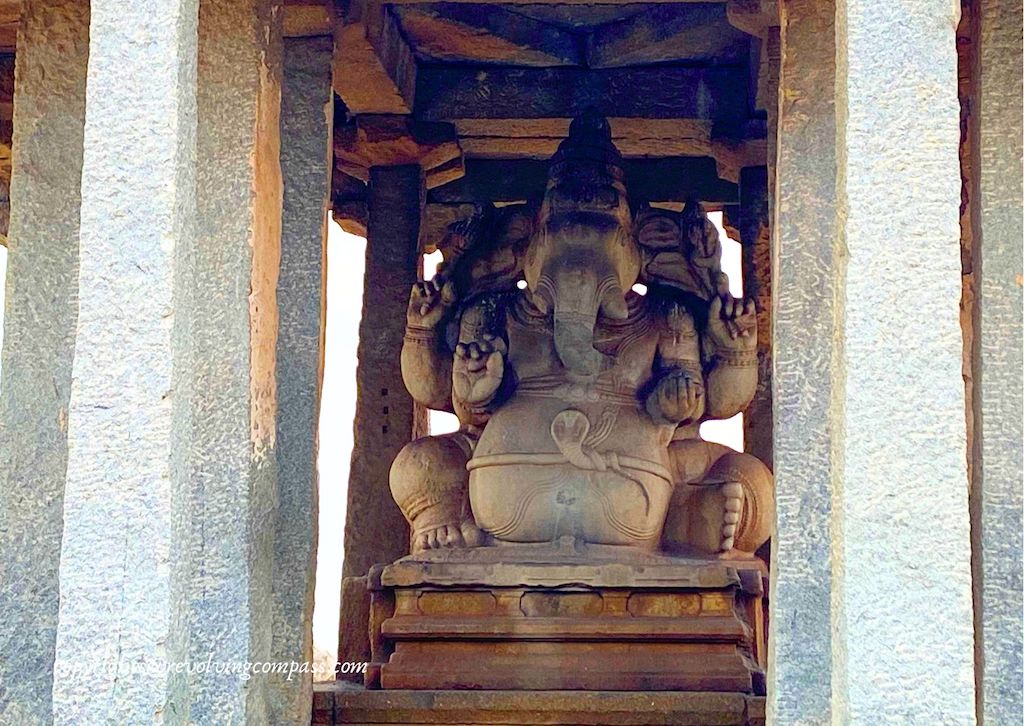
If you pay attention, you will see a snake around the stomach of Ganesha. There is a mythological story behind it. It goes such that Ganesha, who was very fond of food overate one day. So much so that his stomach was on the verse of bursting. So, he tied a snake around it to prevent his stomach from bursting.
Kadlekalu Ganesha Temple Hampi
As you come out of the gate of Sasivekalu Ganesha and walk on the road back towards Virupaksha Temple, you will find another Ganesha Temple soon after. This one, called Kadlekalu Ganesha Temple is much larger than Sasivekalu Ganesha. It has a proper outer hall supported by pillars. And an inner sanctum where the actual Ganesha idol resides. The pillars of this temple are also hugely carved and adorned with depiction of Gods, Goddess and incidence from mythological tales. Unlike Sasivekalu Ganesha Temple whose pillars are completely plain.
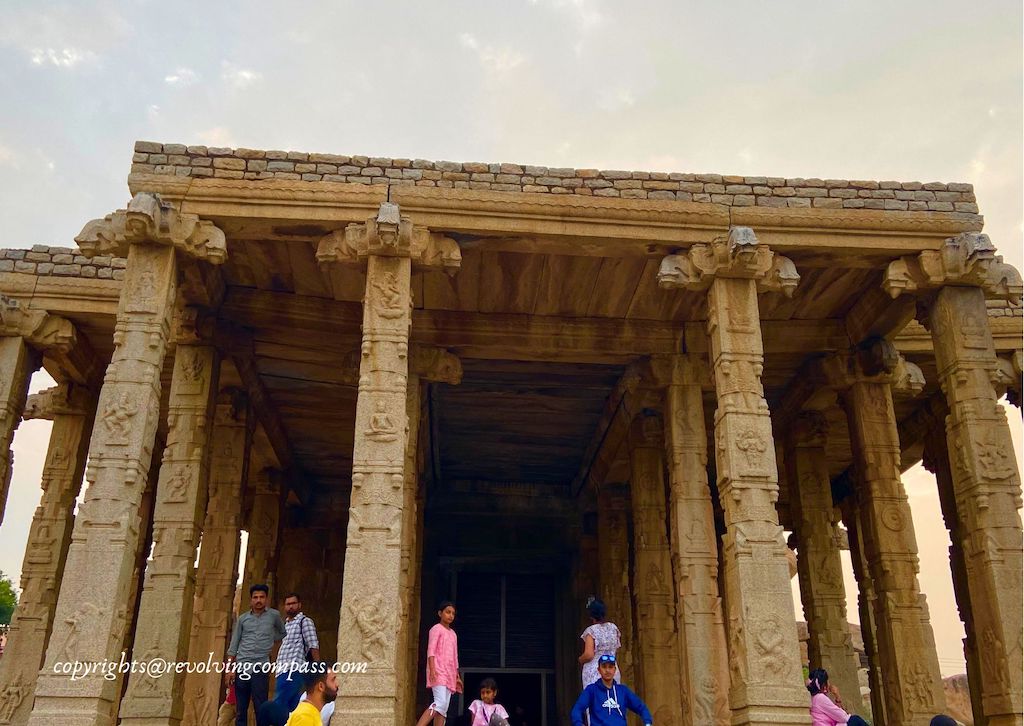
The word “Kadlekalu” literally means “Bengal Gram”. Since the stomach of this Ganesha resembles a bengal gram, hence the name.
Sri Lakshami Narashimha Temple Hampi
Narshimha means half man half God. It is an avatar that God Vishnu took to protect Prahalad. Sri Lakshami Narashimha Temple lies a little away from rest of the above places you might have seen so far. So, you can drive upto this temple and park near it. Most of the structures of this temple are destroyed. And the idol of Sri Lakshmi Narshima is also damaged. But, you can still feel it’s grandeur.
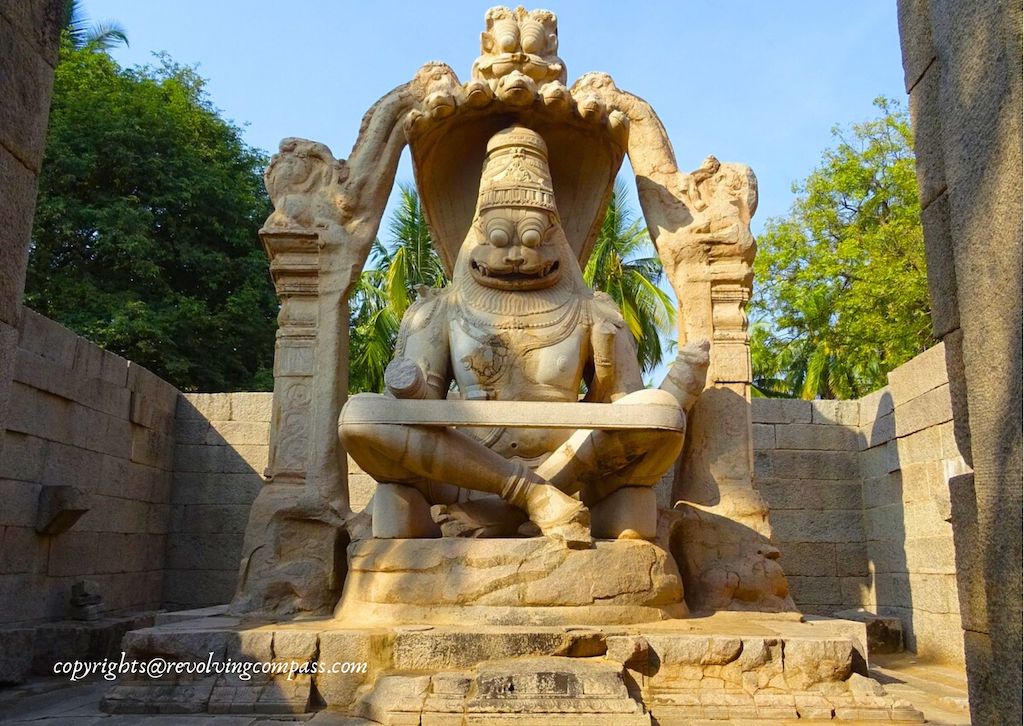
The idol is a huge Narashimha, sitting under the hood of Sheshnag. With a fierce face and protruding eyes.
Hampi Sri Krishna Swamy Temple & Krishna Bazar Hampi
Around 200m north of the Narashimha Temple lies Sri Krishna Temple.
And opposite this temple lies the Hampi Bazar – one of the seven main markets of Hampi where international trade used to take place at the time of Vijayanagara Empire.

Sri Krishna Swamy Temple is the second temple that I have visited in India after Udupi Sri Krishna Temple on my recent coastal Karnataka road trip, which had a balkrishna (child form of Krishna) established as the main idol. This is also one of the most huge temples of Hampi. Almost comparable in size to the Hazara Rama Temple that I had visited the previous day while exploring the royal enclosure of Hampi. The pillars of the main temple are highly ornate. With stories from various Hindu epics adorning different pillars.
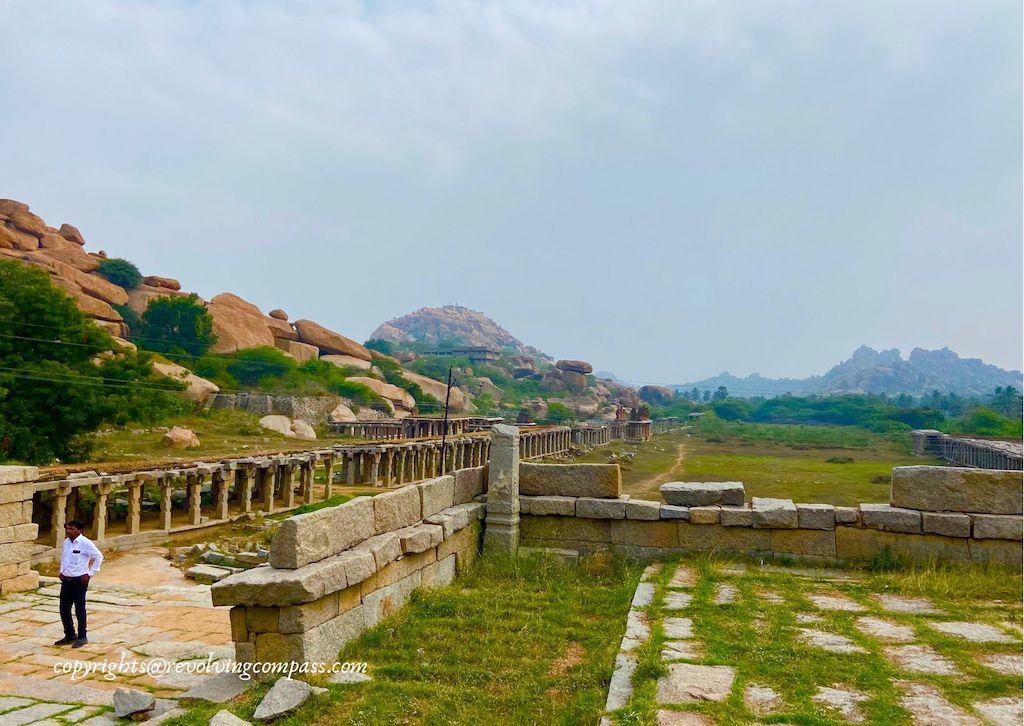
It is believed that Krishna Bazar was a street with shops on both sides that led the way to Sri Krishna Temple entry. On the other end of the bazar is the temple pond which still has water. In the present days, this water is used for irrigating the nearby farms.
Hampi Bazaar
After visiting Krishna Bazaar Hampi, you can trace your steps back near Virupaksha Temple. And follow my map to reach Hampi Bazaar, opposite to Virupaksha Temple. This market was one of the most huge and prominent markets of the thriving kingdom of Vijayanagara. In fact, it had not one but two storied, well organised pavilions where the market thrived.
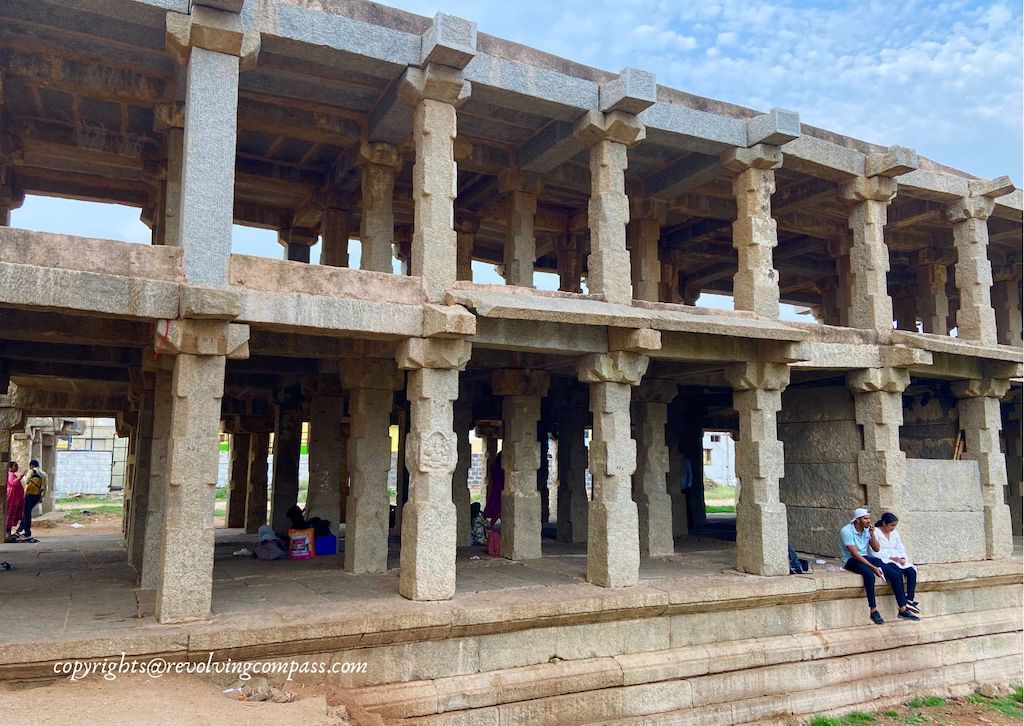
Monolithic Nandi Hampi
This is a large statue of monolithic Nandi Bull standing at one end of the Hampi Bazaar. Near the Nandi, there is a photography exhibition showing different sites of Hampi and Hampi archeological ruins photos.
Tungabadra views of Hampi & Tungabadra Coral Ride Point
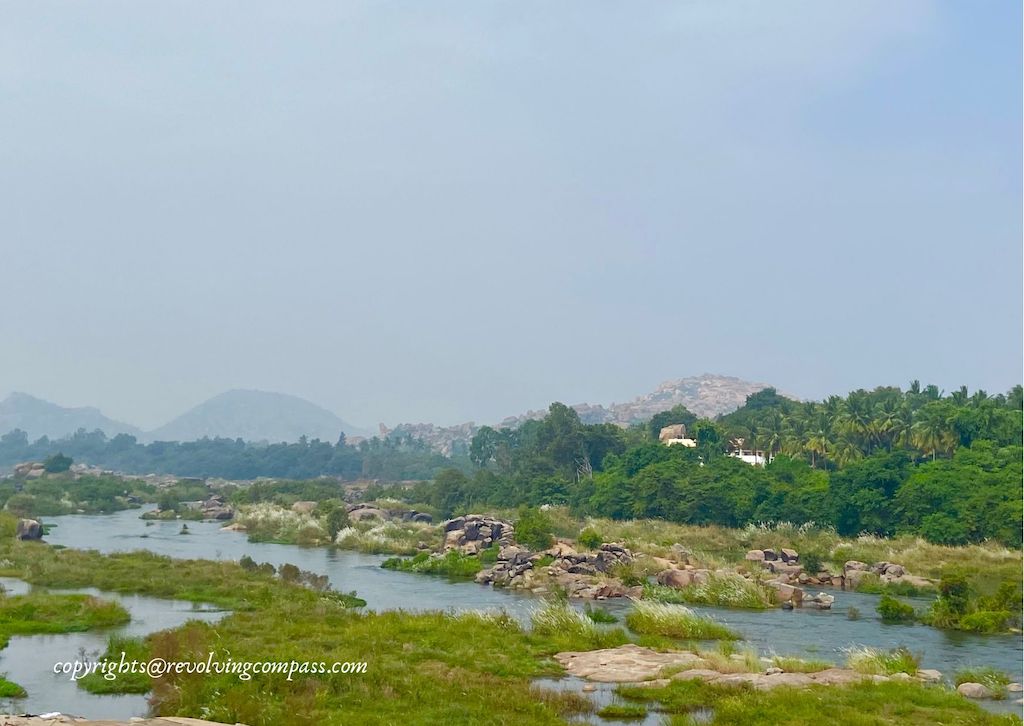
Sri Kodanda Rama Temple Hampi
Situated in front of the Chakrathirtha ghat of Tungabhadra river, Sri Kodana Rama Temple is our last stop while exploring Virupaksha Temple and around amongst the ruins of Hampi. It is a beautiful temple dedicated to God Ram. It contains huge statues of God Ram, his wife Sita, and his brother Lakshamana. The unique feature of this temple is a statue of Sugriva bowing to Sri Rama.
This temple has Hoysala and Dravidian style of architecture. However, some even believe that this temple exists since the time of Ramayana. As this is where Sugriva carved out the statues of Ram, Sita and Laxman to worship. And this is also the spot where Ram killed Vali.
Although we ended our trail of Virupaksha Temple Hampi and around at this spot. There are many other places to visit in Hampi and around this area. In fact, if you continue along the path further down Sri Kodanda Rama Temple, you will eventually reach the Vijaya Vittala Temple. I have provided the route details on how to navigate all the way to Vijaya Vittala Temple from here in the below section.
Other places to visit in Hampi
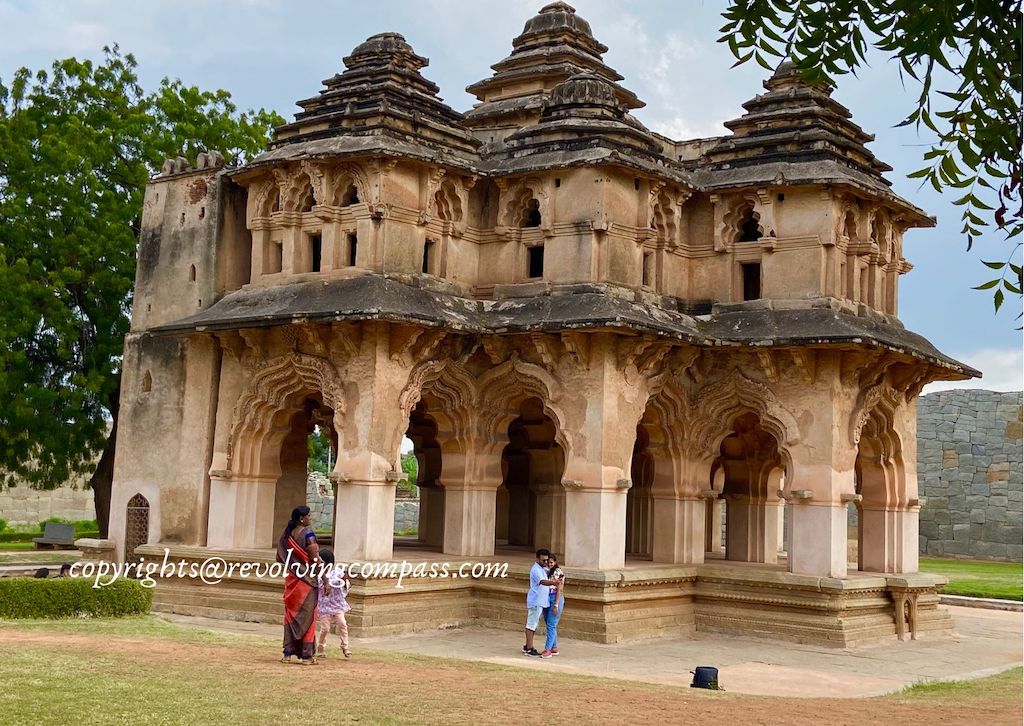
Exploring the ruins of Hampi on your own can definitely be overwhelming. With the ruins scattered across miles and enter-wining lanes all over, it’s very easy to miss some of the major landmarks or ruins of Hampi. This happened with us on our first trip to Hampi. We couldn’t explore around much except for the Virupaksha Temple and it’s surroundings.
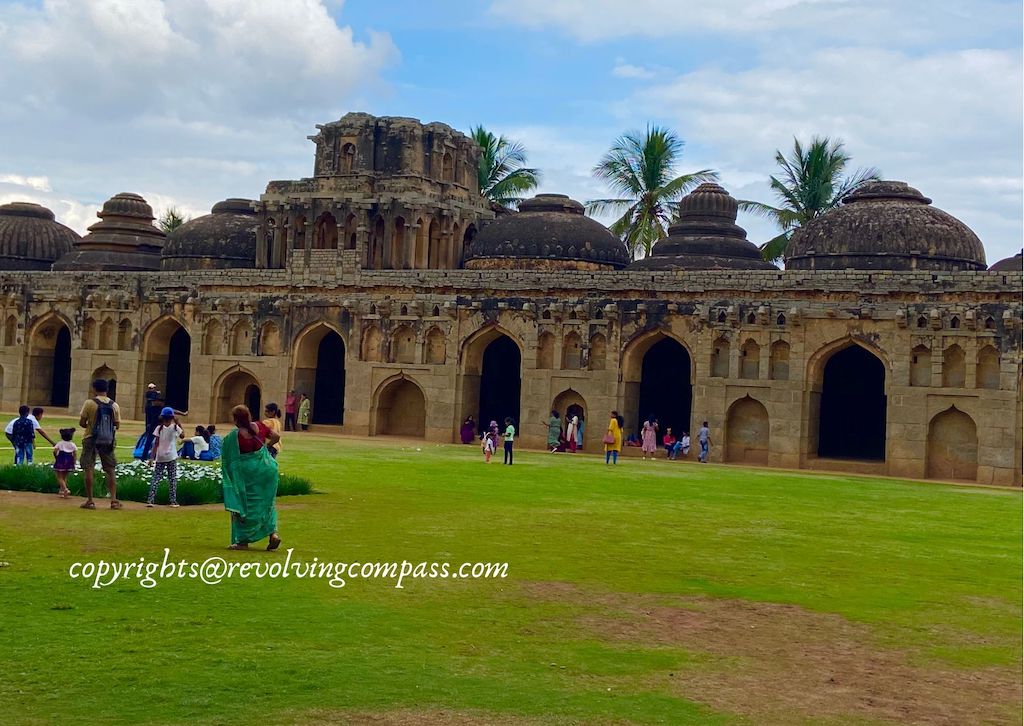
So, this time, I divided the complete list of places to see in Hampi in 5 major parts –
- Virupaksha Temple and it’s surroundings
- Vittala Temple and it’s surroundings
- Royal Enclosures of Hampi
- The Hippie Island Hampi
- Newly developed places to see in Hampi like the Tungabhadra Dam and it’s surroundings
You can explore the above zones or trails at your convenience in any order. We already covered the Virupaksha Temple and it’s surroundings in this post. You can follow the other links for exploring the other two areas as well.
Here’s our complete guide to explore Hampi
It includes information on where to stay in Hampi, how to reach Hampi, when is the best time to visit Hampi, how to explore the ruins of Hampi, how many days trip to Hampi is sufficient etc. Click this link to browse through places to stay in Hampi.
From Virupaksha Temple to Vittala Temple Hampi
Also, from Kodarama Temple, it is possible to continue walking further and reach Vittala Temple along the bank of the river Tungabhadra. Here are some of the sites that one can see while walking on a trail along the river Tungabhadra from Virupaksha Temple to Vittala Temple –
- Narsimha Gudi Mandapa
- Sugriva’s Cave
- Sri Kotilinga Temple
- Seetha Pond
- Double Storeyed Mandapa
- King’s Balance
- Vijaya Vittala Temple Hampi
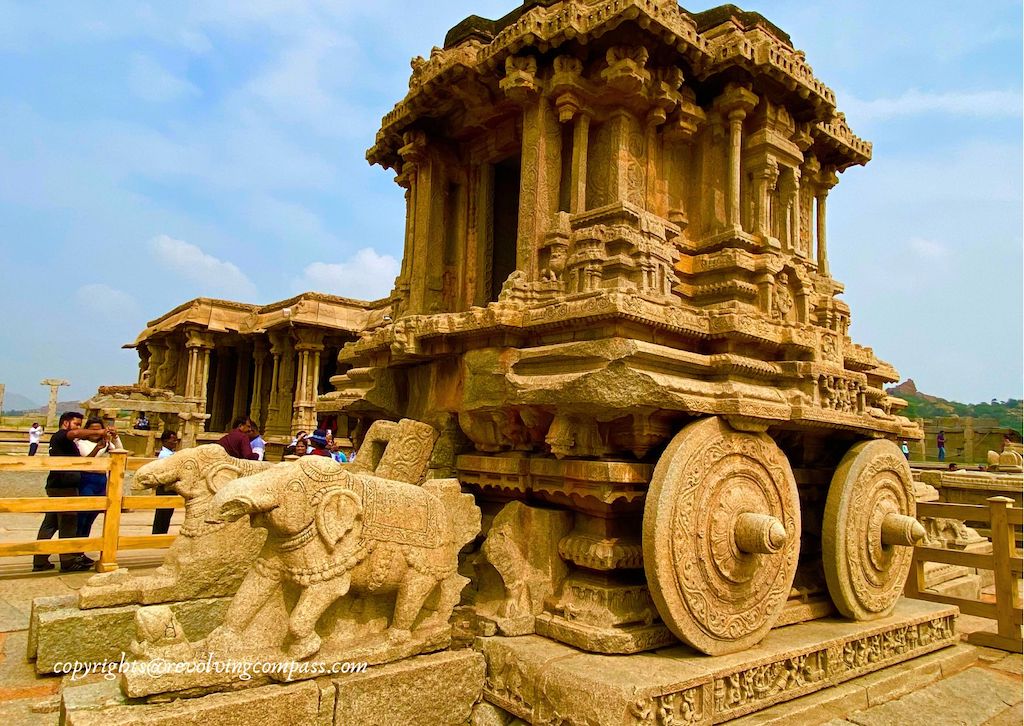
Refer to the below map to see how to navigate from Virupaksha Temple to Vittala Temple –
This is the link to the above map – https://maps.app.goo.gl/pCJw2doZzKdm11U79
If you want to explore around Virupaksha Temple and Vittala temple in one single day. then you should first explore Virupaksha temple and it’s surroundings in the morning. And then proceed towards Vittala Temple as per this trail. Do have lunch near Virupaksha Temple as there are not many options near Vijaya Vittala Temple.
Once you reach Vittala Temple, it will easily take another 3-4 hours to visit this temple and it’s surroundings.
Here’s our complete guide to visit Hampi
Places to visit near Hampi
If you are visiting Hampi, it will be good to extend your trip a bit and visit the cave temples of Badami, the ancient temple complex of Aihole and the UNESCO World Heritage temple complex of Pattadakal as well. You can also explore them on a day trip from Hampi. But it will be very long and hectic day trip. It will be best to halt in Badami for at least one night.
Read : Our trip to Badami Pattadakal and Aihole
If you are visiting Hampi from Bangalore, then you can visit Chitradurga Fort on your way to Hampi. It requires around 3-4 hours to visit here. We have separately visited here on a day trip from Bangalore.
Tips on visiting Virupaksha Temple Hampi
- There is a pathway through the boulders on the banks of river Tungabhadra that connects the lanes near Virupaksha Temple to Vithtala Temple Hampi. If you plan to walk from one to the other, it is possible. We had attempted this path on our first trip to Hampi. But, alas, we couldn’t go all the way to Vithala temple as our first kid was very small and it was very sunny then. Nevertheless, the views of the Tungabhadra river that you get on this path are awesome. So, do give it a try.
- Although Virupaksha Temple remains open till 7:00pm, the other temples in the surrounding like the Kadlekalu Ganesha close by 5:30pm.
- There is no entry fee to Virupaksha Temple or any of it’s surrounding monuments.
- There is a car parking opposite Hampi Bazar, where you can conveniently park your vehicle. The parking fee is INR 10 for the whole day.
- The area near the car parking has several food outlets, small shops selling handicrafts, toys etc.
- For food, there are many good guesthouses in the lanes near Virupaksha Temple. Which have in-house restaurants with freshly made food and an extensive menu. We really enjoyed our lunch at Gopi’s Guesthouse in one of these lanes. The food was fresh, service prompt and menu very extensive. Some of these restaurants even offer river view.
- You need to take off your shoes while visiting Virupaksha Temple. Actually, there is a shoe deposit room on the left side of the temple. You can deposit your shoes here for INR 2 per pair of shoes
- There are quiet a lot of monkeys and langurs on Hemkuta Hills. However, they are completely oblivious to the human presence around them. And I didn’t see them even attempting to go near anyone. They were always busy amongst themselves only 🙂
PS: Some of our links are affiliated, this means we will earn a commission when you buy a service or product by clicking those links. However, this will have no extra cost for you.
